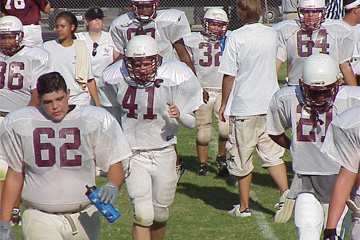
Two new studies on heat exertion among high school football players show only 2.5 percent of certified athletic trainers surveyed complied with national guidelines aimed at limiting heat-related illness.
“These studies show that heat-related events are taking place every year that could result in death,” said Dawn Comstock, Ph.D., associate professor of epidemiology at the Colorado School of Public Health and co-author of both studies. “There are clear guidelines but they are not being followed consistently or widely enough.”
At the same time, the studies found that certified athletic trainers in states with mandated heat management strategies followed heat acclimatization guidelines more closely than those in states lacking such requirements.
The first study, published recently in Medicine & Science in Sports & Exercise, and the second in The American Journal of Sports Medicine, illustrate how easily lives could be saved by following heat exertion guidelines but how often these practices are ignored.
Each year 6,500 high school football players are treated for exertional heat illness and each year a handful die. In 2009, the Inter-Association Task Force, led by the National Athletic Trainers Association (NATA), developed 17 pre-season heat acclimatization guidelines.
The first study found that just 2.5 percent of 1,142 certified athletic trainers surveyed complied with the 17 guidelines.
The guidelines with the lowest compliance rate were: `Single practice days consisted of practice no more than three hours in length.’ 39.7 percent compliance.
`During days 3-5 of acclimatization, only helmets and shoulder pads should be worn.’ 39 percent complied.
On average, only 7.6 of the heat exertion strategies were followed.
“We don’t want to blame the certified athletic trainers for this,” said Comstock, who is also director of the National High School Sports-Related Injury Surveillance System.
“Most are knowledgeable of prevention guidelines but lack either the resources to put them into place or the authority over coaches to enforce them.”
The second study dealt with managing exertional heat stroke (EHS) in high school football players. The potentially fatal condition is characterized by a core temperature of 105 degrees Fahrenheit which can cause major organ failure. Between 1995 and 2010, 35 high school football players died from EHS.
The research found that certified athletic trainers have increased their awareness and proactive treatment of EHS. But the study also showed that more effective, easily implemented strategies are not being widely employed when early symptoms appear.
“Most of the strategies certified athletic trainers reported using were relatively low-level therapeutic interventions, such as removing equipment and clothing, and moving the athlete to a shaded area,” said the lead author of both studies, Zachary Kerr, PhD candidate in the department of epidemiology at the University of North Carolina’s Gillings School of Global Public Health. “Perhaps more concerning, they did not employ more active strategies that could properly identify and manage the condition in a timely fashion.”
Those strategies include using a rectal thermometer to verify core temperature elevation; using ice water immersion on site to accelerate cooling; and notifying emergency medical services (EMS) as quickly as possible.
“These studies are significant because year after year we see young athletes die in ways that are totally preventable,” Comstock said. “It is ridiculous to have another athlete die in this way.”
